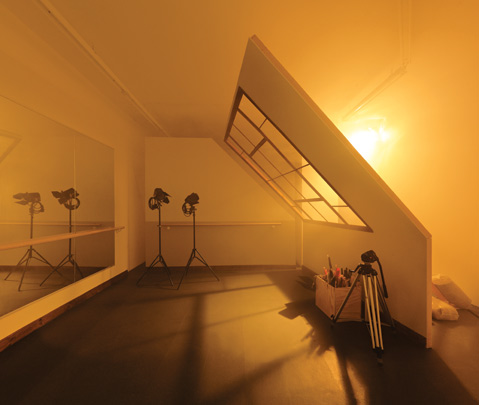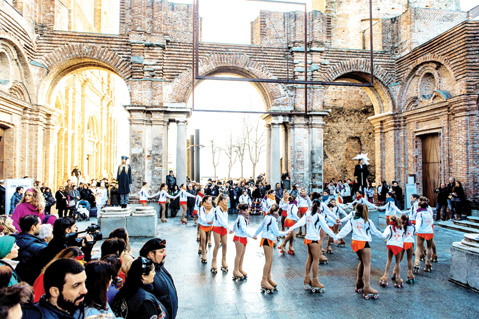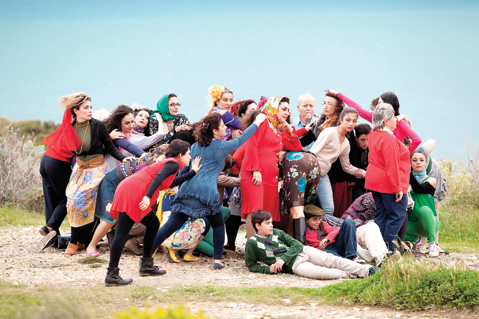Preview: Building Communities at MCASB
Marinella Senatore Makes Art with Other People

When Building Communities opens this weekend at the Museum of Contemporary Art Santa Barbara (MCASB), what’s on the walls will only be a small part of what the artist will create by being there. In addition to documentation of a number of her previous projects, Italian artist Marinella Senatore will display three installations designed to invite ongoing participation from members of the Santa Barbara community. In the entryway of the gallery space, Senatore has put together something she calls “Movie Set.” The apparatus includes moveable walls, mirrors, dance bars, cinema lighting, and a professional-grade movie camera. Visitors to the museum may book time in the studio through the MCASB website and then use it as an open platform for creating original short films. Across the room from this Little Hollywood, there’s “The School of Narrative Dance,” a dance floor and several video monitors installed to give visitors the opportunity to study a sequence of suggested movements on the video screens and then take turns trying them out on the dance floor. Finally, in the main gallery space, a writing workshop area hosts participants who have proposed stories for eventual production and who must come to the gallery in order to collaborate on them with the artist. Interspersed among these community workstations, there will be multiple examples of Senatore’s work from all over the world: She’s created pieces in Spain, Great Britain, Ireland, and New York, among other places. The largest of these projects is an opera called Rosas, which included more than 20,000 people. I spoke with Senatore in the MCASB gallery last week as she was supervising the installation.

I know you were trained as a cinematographer in Italy, but it’s harder to place you after that. Where do you consider home? After growing up in Italy, the most time I have spent in one place was eight years in Spain, but since then I have been all over the place. I’m based in Berlin now, but after Santa Barbara, I will travel to Rome to complete a project I started there, and then it’s on to London, where I have something else to do. Because of my work, I’m constantly on the move, so I’m not sure I have a home.
Your projects involve coordinating large-scale productions with untrained people, and often the participants speak a different language than you do. Is that a challenge? Do you work with a translator? I do work with large groups and with all kinds of people, and yes, language is an issue. When I was in New York, I was in Harlem, and there were a lot of rappers, and they were hard for me to understand at first even though I do speak English. On another project, I worked with over 1000 people who were deaf, and I had to learn sign language for that. But I don’t like to use translators. I don’t really trust that process, so I have to make do with gestures and whatever common language we can come up with on the spot. It’s a challenge, but I feel like you just have to forget it’s a problem and then get to work.
How long does it take for you to create a work? In the case of an exhibition like this one, where it’s primarily a retrospective, I can do it with only a few weeks, but when I am creating an entire new project, I need to live in the community for a period of months. It’s not like I can find what I need to know about a place on Wikipedia. I may suggest the form of the final outcome, but my process is to activate a location by putting other people together. The medium changes — sometimes we’re doing video, but other times it could be a film or a dance or even a radio program. And there’s no specific plot to it before the process begins. I negotiate with the team, so a lot depends on how well I discover in them what they have to offer. The intention I meet with from people most often is some variation on the desire to write the story, and that’s fine with me. In fact, I like that.
What in particular about your training or your personality do you think has made you so suited to this approach? I trained as a director of photography at Cinecittà, and that gave me the confidence to operate at a large scale and to be a strong woman in the man’s world of the set. But I think the roots of my approach lie even deeper because in my youth I was a violinist, and I played in symphony orchestras, and that’s what I identify with still: the choral structure of the orchestra, with many players coming together on a single piece. When 90 or 100 musicians are playing the same symphony, they experience the music as a common goal, and that’s what I’m after in my work, that experience.

Your practice seems quite removed from that of painters and sculptors, who create valuable objects that are then traded by dealers and collectors. Is that intentional? Well, I’m from a Southern Italian family, and I’m still a very, very working-class girl at heart. This is why I choose to work with these people that I recruit in a location, people who are often inexperienced, rather than to collaborate with expensive professionals as in the traditional film industry, for example. When I am in the middle of a project, I don’t want to feel like I’m the artist or I’m the educated one and you are not. I believe in this idea of a culture that comes from below where the artist is, alongside the other participants as an activator. You know I’ve worked with over 60,000 people at this point, and it has still always been a mutual exchange experience. The people I collaborate with want to see my face; it’s important for their dignity that I acknowledge them directly and in person. With each participant, I am making a deal. The agreement we reach together is just a small part of the overall work, but it’s a very important part.
How do you balance these thousands of relationships with your personal life? Ha. I don’t! This is my personal life. I work all day, and then I call and Skype sometimes all night with people who are on other continents. I do sometimes get stressed when I see that I’ve got 8,000 new calls on my phone, for example. That’s a little scary. But it’s my skill, doing this. It is what I love. I can get involved with large groups of people because I’m not scared of using cameras, because I know that I can work well with big groups, and because I know how to keep the energy on a set really high for long periods. When I need to, I can run for days on pure adrenaline.
4•1•1
Marinella Senatore: Building Communities opens on Saturday, May 10, and continues through Sunday, August 17, at the Museum of Contemporary Art Santa Barbara (653 Paseo Nuevo). For information and hours, visit mcasantabarbara.org.



